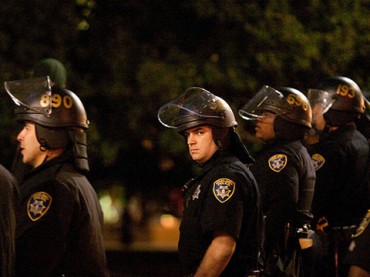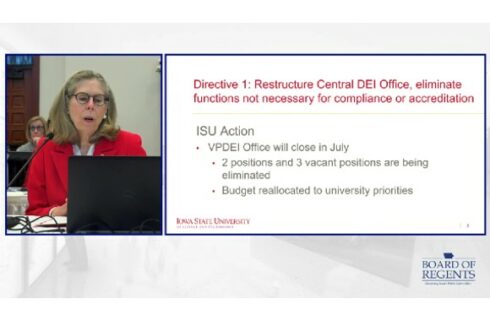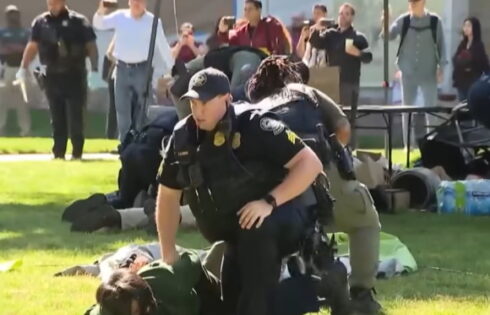
PHOENIX- College students are known for their irrational, impulsive behavior, but in the past year they have seemingly outdone themselves by turning anything into a riot, from house parties to sporting events to political protests.
In the course of the academic year, students have filled national headlines with tales of violent, disorderly conduct during riots that resulted in property damage, injuries and arrests.
One of the most notable incidents of rioting took place on April 5 near the University of California, Santa Barbara campus, during the annual unsanctioned spring break party known as Deltopia.
The block party turned violent when a minor hit a university police officer in the head with a backpack containing glass liquor bottles, causing the officer to sustain a significant head injury, according to the Santa Barbara County Sheriff’s Office.
The police then declared the scene an unlawful assembly, but the situation soon escalated out of control when partygoers began to “throw objects at police, burning mattresses, ripping up stop signs, destroying car windshields and damaging police vehicles,” according to the Daily Nexus.
Law enforcement resorted to using tear gas and rubber bullets to get an estimate crowd of 20,000 to 25,000 people to disperse.
In the course of the riot, 130 arrests were made, 190 citations were issued and 44 individuals were transported to the hospital to receive medical treatment, according to the sheriff’s department.
The apparent surge in this violent behavior by college students has led to debate over the cause of the rioting, with some attributing it to immaturity and impulsiveness, combined with judgment-altering substance abuse.
Psychoanalyst Ken Eisold, the former president of the International Society for the Psychoanalytic Study of Organization, suggests that the underlying cause might be something else entirely, though.
“The basic motive is fear,” said Eisold, the author of What You Don’t Know You Know: Our Hidden Motives in Life, Business, and Everything Else, in an interview with The College Fix. “People don’t act up in that way and do that kind of thing unless they’re afraid of something.”
College students have plenty to fear, according to Eisold, due to anxiety over post-graduation life.
“Their situation is not a comfortable one. The job situation is really very, very bad, and colleges are frightfully expensive, so [students] are basically going heavily into debt,” Eisold said. “They know they’re going to need to work to get out of it, but at the same [time] they don’t see how they’re going to do it.”
As a result, Eisold says that college students are rioting to gain a sense of being in control of their otherwise uncontrollable life.
Students “really can’t do a lot because in a certain sense they’re trapped in their roles – they have to get good grades, they have to attend classes,” Eisold said. “But at the same time, there are these things that are happening in the world that make them quite anxious,” putting students into a sort of “psychological squeeze.”
Police response to the scene of a riot also might be a factor in its further escalation, according to Eisold.
“I think sometimes what happens is the police get scared too, and they tend to overreact, then you kind of get into a shouting match, which then escalates the level of violence,” Eisold said.
Actions such as this demonstrated by law enforcement can serve as justification for rioting in the minds of students, according to Eisold.
“In addition to being kind [of] scared, [students] get really, really angry. Then they feel justified,” Eisold said. “And I think that if they’re feeling as if they’re justified because they have a bad authority figure acting in a disruptive, oppressive way, there’s no stopping them. Then the thing escalates out of control.”
The police response to a riot at the University of Arizona following the basketball team’s loss during the Elite Eight round of NCAA’s March Madness tournament on March 29 provoked further violence and civil disobedience in riot participants in addition to claims of police brutality.
Arizona basketball fans began to filter out of bars and restaurants onto the streets after the Wildcats lost to the University of Wisconsin Badgers by one point, 64-63, in overtime.
Law enforcement officials issued an order to disperse and declared the scene an unlawful assembly, but disappointed fans “began throwing beer bottles, beer cans and firecrackers at the officers,” according to a statement issued by the Tucson Police Department.
Police, clad in full riot gear, used pepper spray and shot rioters with pepper ball rounds to contain the riot and restore order.
Those present at the riot refused to back down, and began to push back again the police line while chanting expletive phrases.
Claims of police brutality began when one riot participant approached the police line, seemingly taunting officers while being shot repeatedly with pepper ball rounds as the onlooking crowd cheered him on. He was rushed and beaten by officers as they dragged him back through the police line.
Further claims of brutality surfaced after a video depicting an officer – who seemingly assaulted an uninvolved bystander by knocking her over – went viral on the Internet, garnering national outrage.
A total of 15 individuals were arrested in the course of the clash with police, nine of which were students at the university.
Psychoanalyst Eisold suggests that the amount of attention the riots have garnered in the media may also be a contributing factor to the increase in rioting among students across the country.
“The fact [is] that if it becomes sort of popular or well known, there is a kind of contagion effect, almost like an invitation,” Eisold said.
Regardless of the causes of the rioting, which “is a release” for the pressures on students, it’s “obviously not a solution,” Eisold said.
College Fix contributor Julianne Stanford is a student at the University of Arizona.
Like The College Fix on Facebook / Follow us on Twitter
IMAGE: Thomas Hawk/Flickr





Please join the conversation about our stories on Facebook, Twitter, Instagram, Reddit, MeWe, Rumble, Gab, Minds and Gettr.